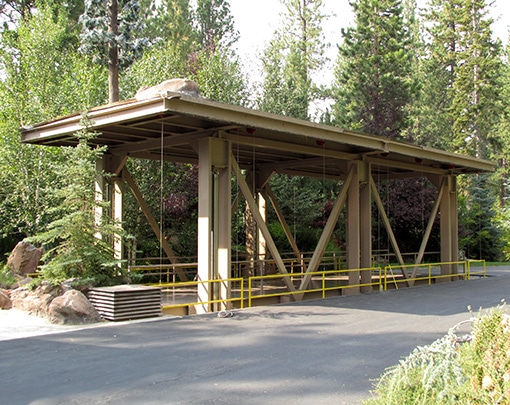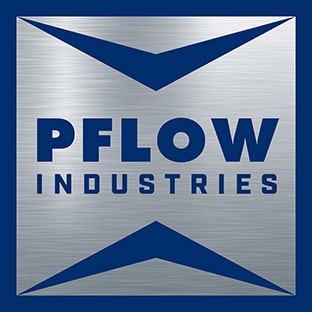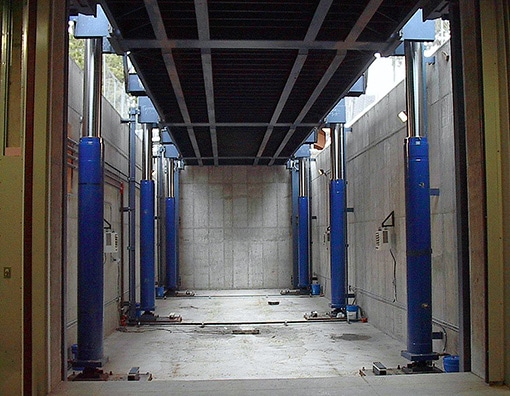Search Knowledge Base by Keyword
-
Case Studies
- A Sugary Sweet Lifting Solution for Peeps & Company Retail Store
- Bayside Harley’s Product Showcase and PFlow Bring in the Riders
- Books Arrive in Underground Archive with the Help of a PFlow Conveyor
- Creative Design Highlights Vertical Conveyor at Laminated Glass Plant
- Custom Designed Hydraulic VRCs Help Maximize Space at Tyson Foods
- Custom Designed PFlow F Series Assists with Funeral Services
- Custom PFlow Lift Helps Create 9,600 SF of Storage within Existing Building
- Everything is Bigger In Texas – Including the PFlow M Series VRC!
- For Moving Fragile Cargo, Boeing Called PFlow Industries
- FuelCell Energy Loads Components with the Help of PFlow Material Lifts
- Georgia Pacific Moves Finished Product with the PFlow M Series
- Global Logistics Leader Doubles Productivity with PFlow Lifts
- Gravity Makes the Wine, PFlow Vertical Lift Takes Care of the Rest
- High-Capacity Mezzanine Lift Effortlessly Elevates 15,000 lb Payloads
- Historic Pritzlaff Building Repurposed Into Popular Event Venue with Assist from PFlow Hydraulic VRCs
- Liberated By Upward Mobility
- Manufacturing Plant Replaces 10-ton, 200′ Hoist with PFlow Vertical Lift
- Merged Controls of PFlow Lift and Laundry Cart Washer Regulate the Flow of the Entire System
- Milwaukee Waterfront Deli and PFlow Deliver
- Moving at the Speed of Fashion
- Moving-Floor Assembly Line Streamlines Implement Production
- PFlow and Parking Vault are Solving Major Parking Needs
- PFlow Automated System Provides Continuous 2-Way Pallet Flow
- PFlow Corners the Market for 'Big,' Heavy-Duty Material Lifts
- PFlow Designs Lift for Underground Parking at a Lake Tahoe Home
- PFlow F Series Helps Retailer Utilize Difficult-to-Access Space
- PFlow Galvanizing Provides a Protective Coat for Juice Plant Lift
- PFlow Heliport Lift Helps Offshore Oil Platform
- PFlow Helps Repurpose Restaurant into Government Service Facility
- PFlow Hydraulically Powers the Upward Expansion at Alcom Electronicos Reynosa Facility
- PFlow Lift Integrates Perfectly with 10-Story Power Plant Tower
- PFlow Moving Concourse Helps 'Big Bertha' March Into College Stadium
- PFlow Navigates Uncharted Territory with Vertical Lift at Naval Drydock
- PFlow Pallet Elevator is the Vertical Lift Solution for Nutrilite Warehouse
- PFlow Provides Steady Travel for Lockheed Martin Missile Plant
- PFlow Retrofits 2 Lifts in Single Shaft to Keep Hospital Supplies Moving
- PFlow Screw Lift Provides a Safe and Controlled Movement of Satellites
- PFlow System is an Integral Part of the Paper Production Line
- PFlow VRC Keeps the Pipeline Full for Large Pharmaceutical Distributor
- PFlow VRCs Help Keep the Beer Crisp and Chilled at NFL Stadium
- PFlow VRCs Installed in Concrete Shaft Ways of Seattle Tunnel Project
- PFlow VRCs Provide Vertical Logistics at High Rise Audi Dealership
- Stage Lifts Spirits – and Nascar Vehicle
- Tower Above the Competition with a PFlow Vehicle Display System
- Unique Lift System Enables Installation and Servicing of Telescope Mirrors
- Show all articles ( 30 ) Collapse Articles
-
Preventive Maintenance
- 21 Series Hydraulic Lift - Preventive Maintenance Checklist
- B Series Box Lift - Preventive Maintenance Checklist
- D Series Hydraulic Lift - Preventive Maintenance Checklist
- DB Series Package Handling Lift - Preventive Maintenance Checklist
- F Series 4-Post Mechanical Lift - Preventive Maintenance List
- M and MQ Series Mechanical Lifts - Preventive Maintenance Checklist
-
Service Bulletins
-
Installation Manuals
- 21 Series - Hydraulic VRC - 2-Post Cantilever - Installation Manual
- 21 Series - Hydraulic VRC - 2-Post Straddle - Installation Manual
- B Series - Box Lift - Owner's, Installation, and Maintenance Manual
- D Series - Hydraulic VRC - Installation Manual
- DB Series - Package Handling Lift - Owner's, Installation, and Maintenance Manual
- F Series - Mechanical VRC - 4-Post Installation Manual
- M Series - Mechanical VRC - 2-Post Cantilever - Installation Manual
- M Series - Mechanical VRC- 2-Post Straddle- Installation Manual
-
Owner's Product Manuals
- 21 Series - Hydraulic VRC - Owner's Manual
- B Series - Box Lift - Owner's, Installation, and Maintenance Manual
- D Series - Hydraulic VRC - Owner's Manual
- DB Series - Package Handling Lift - Owner's, Installation, and Maintenance Manual
- F Series - Mechanical VRC - Owner's Manual with Eurodrive
- F Series - Mechanical VRC - Owner's Manual with NORD Motordrive
- M Series - Mechanical VRC - Owner's Manual with Eurodrive
- M Series -Mechanical VRC - Owner's Manual with Nord Motordrive
-
Dimensional Schematics
- 21 Series CSI Spec - No Quick Connect
- 21 Series CSI Spec - Quick Connect
- 21 Series Hydraulic Lift - Cantilever Style - Dimensional Schematic
- 21 Series Hydraulic Lift - Straddle Style - Dimensional Schematic
- 21 Series, Cantilever, CAD Drawing
- 21 Series, Straddle, CAD Drawing
- B Series Box Lift - Dimensional Schematic
- Bi-Panel Swing Gate Dimensions
- Bi-Panel Vertical Gate Dimensions
- D Series CAD Drawing
- D Series CSI Spec - No Quick Connect
- D Series CSI Spec - Quick Connect
- D Series Hydraulic Lift- Dimensions Schematic
- DB Series CAD Drawing
- DB1 Series Package Handling Lift - Dimensional Schematic
- DB2 Series Package Handling Lift - Dimensional Schematic
- F Series 4-Post Mechanical Lift - Dimensions Schematic
- F Series CAD Drawing
- F Series CSI Spec
- M Series 2-Post Mechanical Lift - Cantilever Style - Dimensions Schematic
- M Series 2-Post Mechanical Lift - Straddle Style - Dimensional Schematic
- M Series CSI Spec
- M Series, Cantilever, CAD Drawing
- M Series, Straddle, CAD Drawing
- Single Panel Vertical Gate Dimensions
- Single Sliding Gate Dimension
- Single Swing Gate Dimensions
- Show all articles ( 12 ) Collapse Articles
-
Applications
-
Videos
-
Gate Installation Instructions
- 15709-0005 - Gate Installation - Sliding - Swing - Bi-Parting
- 15709-0014 - Gate Installation - Bi-Panel Vertical Acting
- 15709-0120 - Gate Installation - Floor Level Swing with Sliding Latch
- 15709-0126 - Gate Installation - Floor Level Bi-Swing with Sliding Latch
- 15709-0133 - Gate Installation - Motorized Single Vertical Acting
- 15709-0143 - Gate Installation - Motorized Bi-Panel Vertical Acting
- 15709-0156 - Gate Installation - Single Vertical Acting
- 15709-0157 - Gate Installation - Carriage Mounted Single Vertical Acting
-
Safety Data Sheets
- 15713-0001 - SDS, Lubriplate 930 AAA
- 15713-0002 - SDS, Mobil SHC 630, Standard Synthetic Oil
- 15713-0003 - SDS, MobilGear 600 XP 220, Standard Base Oil
- 15713-0004 - SDS, Shell Omala S4 GX 220, Gear Lubricant
- 15713-0007 - SDS, Paint, Enamel - PFlow Blue, Aerosol
- 15713-0008 - SDS, Exxon MobilGrease XHP 222 Special
- 15713-0011 - SDS, Paint, Fast Dry Acrylic Enamel, PFlow Blue
- 15713-0012 - SDS, Paint, Universal Primer, PFlow Primer II
- 15713-0014 - SDS, Hydraulic, Biodegradable, Clarion AW Oil 32
- 15713-0015 - SDS, Weld-Aid Brite Zinc B-100, Aerosol
- 15713-0018 - SDS, Shell Omala S2 G 220, Gear Lubricant
- 15713-0021 - SDS, Fast Cure Epoxy, Macropoxy 646 (Part A) Mill White
- 15713-0022 - SDS, Dow Corning Oil, Molykote L-1468FG, Synthetic Freezer Chain Oil
- 15713-0023 - SDS, Mobil SHC CIBUS 220, Synthetic Oil
- 15713-0026 - SDS, Eureka Fluid Film Aerosol, Corrosion Inhibitor
- 15713-0028 - SDS, Benz Oil DEXRON III, ATF Hydraulic Fluid
- 15713-0031 - SDS, Shell Omala S4 GX 150, Gear Oil
- 15713-0035 - SDS, Starfire Multi-Purpose ATF Dexron III/Mercon
- 15713-0036 - SDS, Clarion Food Grade Machinery AW 32, Hydraulic Oil
- 15713-0038 - SDS, Paint, Safety Yellow, Aerosol
- 15713-0039 - SDS, Paint, Safety Yellow, Enamel
- 15713-0042 - SDS, Roll-on Paint, PFlow Blue
- 15713-0043 - SDS, Mobil SHC Gear 220 Synthetic Gear Lubricant
- 15713-0044 - SDS, LPS Cold Galvanize BrightCoat Aerosol
- 15713-0045 - SDS, CRC Dry Graphic Lubricant
- 15713-0046 - SDS, Duraspar 130 Gray Primer
- Corothane Exterior Epoxy - Safety Data Sheet
- Corothane Exterior Epoxy Hardener - Safety Data Sheet
- Show all articles ( 13 ) Collapse Articles
PFlow Designs Lift for Underground Parking at a Lake Tahoe Home
What do you do if you own dozens of expensive sports cars, luxury cars, vintage cars and motorcycles, but live in an area where real estate is limited and a large above ground parking structure would be considered unsightly?
Underground parking is an obvious option, but what if you also needed to park three large recreational vehicles, a 55’ offshore racing boat and a helicopter?
That is precisely the question that faced an Incline Village, Nevada, resident in the Lake Tahoe area.
In response, AIA Architects of Reno, Nevada, designed a parking facility or “carriage house” consisting of three levels, two above ground and one below.
Lake Tahoe, Nevada
Residential Underground Parking Access
- Six-Post Hydraulic Lift
- Lifts Loads up to 200,000 lbs
- 16’ Vertical Rise
- 2 Levels of Vertical Rise
- 7’ FPM Travel Speed
 The uppermost level has more than 2,300 sq. ft. of living space, including two bedrooms, two baths, a living room, office/den, kitchen and a deck overlooking the lake. The other two levels are for parking.
The uppermost level has more than 2,300 sq. ft. of living space, including two bedrooms, two baths, a living room, office/den, kitchen and a deck overlooking the lake. The other two levels are for parking.
At the driveway level there are 2,000 sq. ft. of space and below grade, more than 6,100 sq. ft.
Building a ramp to the underground garage would have consumed valuable real estate, so the concept called for a hydraulic lift with a platform large enough to accommodate the largest vehicle: a 55’ long recreational vehicle weighing in at more than 50,000 lbs.
Total Lift Weight Exceeds 100 Tons
The lift needed to retract completely into a 13’ deep pit, followed by the 90,000 lbs. “lid” of steel and concrete that doubles as part of the driveway when in the lowered position. Add the platform itself, and the total weight to be lifted would exceed 100 tons.
The fact the lift must fully retract into the pit and yet be flush with the driveway when raised required that the platform guides terminate some distance below grade, presenting a formidable design challenge.
A shallow water table and environmental concerns precluded a deep pit under the platform. The short length of engagement between the platform and guides would offer little help in keeping the platform level under uneven loading.
PFlow was contacted to design and manufacture a state-of-the-art lifting system. To ensure a level platform throughout travel, and to provide accurate positioning at loading and unloading points, a servo-hydraulic system was incorporated.
 Hydraulic Cylinders Raise, Lower Platform
Hydraulic Cylinders Raise, Lower Platform
Lifting is accomplished via six 12” bore telescopic hydraulic cylinders and a 75 hp, 600-gallon hydraulic power unit delivering 160 gpm. Oil is supplied to each cylinder through an independent hydraulic circuit with servo-proportional control valves for regulating flow.
To track position, individual linear transducers are incorporated on each cylinder providing absolute position feedback to the multi-axis servo control module. Through this module, position, velocity, drive level, position error and many other values can be monitored in real time and plotted. The parameters for each axis can also be tuned independently.
With absolute position data available for each cylinder, important safety-monitoring functions were possible. The system automatically stops travel if any cylinder axis fails to follow the prescribed path within a pre-set tolerance, or if an axis goes out of synchronization with any other axis.
A programmable logic controller is used to link the servo controller to the rest of the system, receiving signals from position switches and other input devices, monitoring system status and controlling the operation of the hydraulic power system and the safety features. Fault diagnostics and audible/visual alarms indicate action required by the operator: to reset the system or call for service. If the platform drifts downward at the upper level, it will automatically re-level.
PFlow is not a stranger to unusual and challenging lifting applications. Previous designs include systems for operating 18,000 lbs. windows in a Florida mansion, lifting and transporting cruise missiles during testing, and raising 300,000 lbs. fuel cells during their manufacture. Other vehicle handling lifts include platforms traveling at 400 FPM, delivering automobiles in a fully automated parking system.

 Hydraulic Cylinders Raise, Lower Platform
Hydraulic Cylinders Raise, Lower Platform